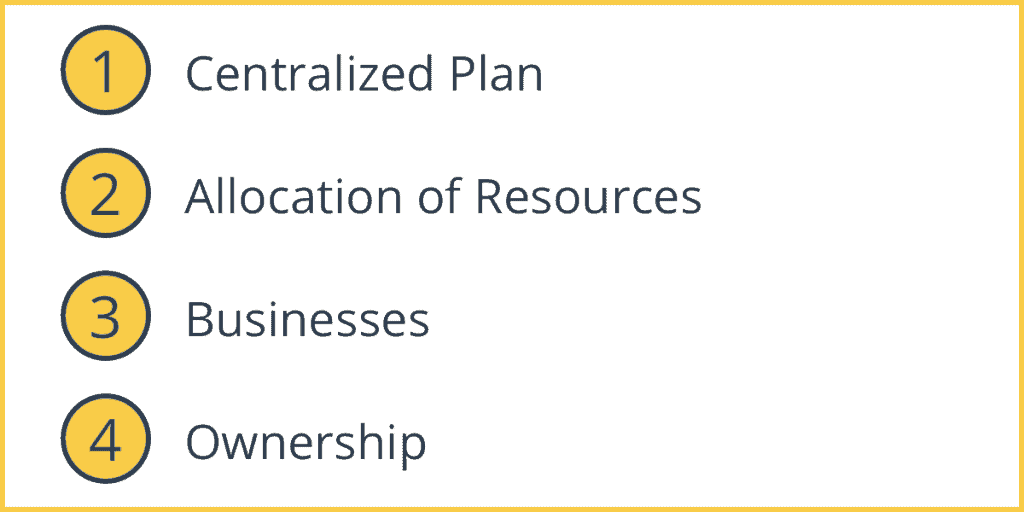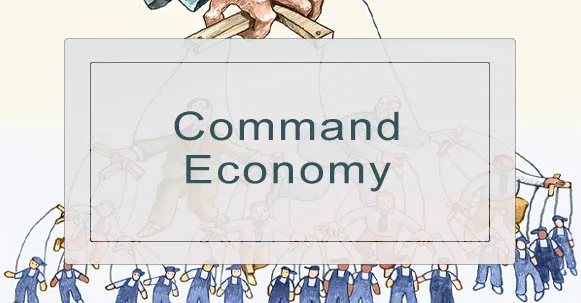In a command economy system, it is not the free market but the government that makes important decisions like which goods to produce, what amount of these goods to produce, and how much they cost. The government also makes decisions about incomes and investments. The government or the collective holds ownership of the means of production as well as of land. A command economy can also be described as a centrally-planned economy.
A command economy is the opposite of a free market economy. Free market economies are distinguished by the production of goods and services through private enterprise. They are ruled primarily by the market forces of supply and demand, rather than by the decisions of a central government body.
Command economies are the hallmark of communist societies. Communism was first described in detail by Karl Marx, who authored The Communist Manifesto along with Friedrich Engels in 1848. They argued that the means of production should be owned commonly by the people, rather than by a select wealthy and powerful few in society.
Five Key Features of A Command Economy

It is easy to identify a command economy in the modern era by looking out for these five main features:
1. Centralized Plan
The economy has a centralized plan for the economy, typically with goals for different sectors of the economy as well as for different areas of the country.
2. Allocation of Resources
The centralized plan includes decisions about how to allocate resources for the production of particular goods and services. It uses tools like quotas and price controls to put these decisions into practice.
The government sets goals and national priorities such as encouraging economic growth, increasing military capacity, eradicating unemployment, and ensuring adequate housing, food, and other survival needs to those in the country.
The government uses this overarching plan to make decisions regarding the use of resources, aiming to put all capital, labor, and natural resources to effective use with a minimum of waste.
3. Businesses
Businesses make decisions according to the government’s central plan, rather than in response to the forces of the free market as in a capitalist economy.
4. Ownership
There are monopoly businesses owned by the government in those industries that have been prioritized (e.g. automotive industry, utilities, finance, and so forth). Because these businesses are monopolies, there is no competition for them in the country.
Comparing Command and Free Market Economies
Here is a breakdown of the most important differences between command and free market economies:
- Ownership: In a command economy, industries are owned and run by the government, while in a free market economy, they are owned by members of the private sector.
- Price determinations: In a command economy, prices are set by price controls; in a free market economy, they are set through supply and demand.
- Incentives: Command economies involve minimal incentives for business leaders to be efficient or profitable, while free market economies have the profit motive as incentives for these figures.
- Efficiency: With companies owned by the government in command economies, there is less motivation to be efficient. With the profit motive in free-market economies, again, there is an incentive for efficiency.
- Levels of equality: At best, a benefit of command economies is greater equality thanks to more equal resource distribution, although this can go awry. In a free market economy, inequality may run rampant without strong government regulation.
- Problems with the system: Problems with the command economy include less choice and freedom, bloated bureaucracy, a tendency toward inefficiency, and the likelihood of shortages and surpluses. Problems with the market economy include lack of inherent emphasis on social welfare, the likelihood of wealth and income inequality, and abuse of monopoly power.
Mixed Economies
Although there are plenty of examples of command economies both historically and today (described in the next section), many of these economies have transitioned to mixed economies in recent decades. These are centrally-planned economies that also incorporate elements of market economies, which are governed by laws of supply and demand. In the process of transitioning from a command economy to a mixed economy, governments use strategies like price deregulation and privatization. China is the most well-known example of this transition, having had a command economy for several decades at the time when they incorporated capitalist elements into their economy.
Command Economy Examples
There are many examples of command economies throughout history as well as contemporarily. Here are a few of the most notable examples of command economy countries:
- Russia/USSR: The world’s first communist command economy was established in 1917 by Vladimir Lenin. Following World War II, leader Joseph Stalin strengthened the military and rapidly restructured and reconstructed the economy. The “Gosplan” was the Soviet State Planning Committee, and has been extensively researched and studied. This was also the longest-lasting command economy, existing until the 1980s before the country’s biggest companies came to be owned by oligarchs.
- North Korea: This is the most centrally-planned economy in the world, established by President Kim Il-sung after World War II. The country has been subject to mass starvation and malnutrition created by food shortages, particularly because the resources of the state are primarily invested into the military.
- Cuba: In 1959, Fidel Castro led a revolution and instituted communism as well as a command economy in this country. The country has been subject to an economic, financial, and commercial embargo by the United States since 1958.
- China: Following World War II, Mao Tse Tsung instituted communism throughout China, which included a highly planned economy. Today, although the country increasingly has a market-based economy instead, this is a mixed economy as they are still using five-year plans for the economy as in a more standard command economy.
- Iran: With state-owned businesses the government holds control of roughly 60 percent of the economy. The Iranian government utilizes subsidies and price controls for market regulation, which have contributed to recessions. Sanctions on the part of the United Nations have also contributed to these recessions.
- Libya: Muammar Gaddafi instituted a command economy in 1969, which depended on revenues from oil. When Gaddafi was assassinated in 2011, he had been in the process of beginning to transition the economy to a more market-based system. Today, most Libyans work for the government, rather than for private businesses.
- Belarus: This is a former Soviet satellite state, and is under a command economy system today. The government owns roughly 75 percent of the nation’s banks as well as 80 percent of its businesses overall.
There have been centrally planned economies before Russia’s communist economy was instituted. Two notable examples are the Incan empire in Peru during the 16th century as well as Mormons in Utah during the 19th century.
Pros and Cons of a Command Economy
Like other economic systems, command economies have both positive and negative aspects. Here are some of the most significant positive and negative features of a centrally planned economy:
Positives:
- Resources are allocated with the priority of benefiting social welfare rather than ensuring the highest profits possible
- Command economies have greater control of employment levels than free-market economies because jobs can be created when people need work, rather than only when labor is needed
- Especially good for nationally coordinated action when there are major emergencies like natural disasters, wars, etc. (this is why free market societies often temporarily reduce their hallmark freedoms when these kinds of emergencies arise)
- Resources can be applied for major, large-scale projects without interference from laws, environmental regulations, etc.
- Societies can be transformed rapidly to attain important social goals like literacy, reducing hunger, minimizing maternal mortality, etc.
- In theory, this system prioritizes meeting the basic needs of everyone, rather than some people having more than others
- Command economies can promote rapid economic growth: during the first three Five-Year Plans (from 1928 to 1940) the Soviet Union transitioned very rapidly from a primarily agrarian society to one of the world’s leading industrial societies
Negatives:
- Can discourage innovation that drives the progress of society forward by rewarding leaders for following orders rather than taking possibly beneficial risks
- Production of goods does not always match levels of demand, and when planning does not account for needs accurately, this can necessitate rationing of goods
- With rapid change comes the risk of overlooking the needs of society as a whole, resulting in damaging responses like black markets
- The incentive problem: central planners are themselves humans, so can make decisions for their own interests rather than that of the nation, as well as the lack of wage- or profit-based incentives for managers/workers to do more than the bare minimum of effort to promote efficiency or reduce costs
- Problem of economic calculation: even without the role of selfish incentives on the part of central planners, it is very difficult for those in power to predict exactly how much of each good should be produced, what is the most efficient method for doing so, and so forth (resulting in problems like shortages and misallocation) –in market economies, by contrast, this is determined based on supply and demand
- Bureaucracy is often very extensive and elaborate in command economies, which tends to be inefficient and can delay decision-making in harmful ways


Thank you for the insights – but I must beg to differ on some of the items in this article. Firstly, command economies have a bad rap because they end up ignoring Marxist theory – Karl Marx was explicit that the revolution should be the work of the working classes not intellectuals (like Lenin who was also ferociously intelligent) and peasants. The Russian Revolution was in 2 stages and the second part led to the Bolshevik seizure of power – the ultimate ascendancy of the middle class. The vicious state apparatus that was built AFTER Lenin’s death then set about killing wealthy peasants (Kulaks) and intellectuals.
Secondly, the Communist Manifesto says little about the communist system and how to get there, just some messianic words about the need for an organisation (PARTY) and the dictatorship of the proletariat, with the absorption, not the liquidation, of the middle classes, students and intellectuals. A more rounded view of socialism can be read in Rosa Luxemburg – tragically murdered by the Freikorps – Germany’s forerunner to the Nazi Party.
Finally, Lenin is just Lenin, not Vladimir Lenin, sometimes V.I. Lenin OR Vladimir Illyvich Ulyanov – just semanitcs.
And a final point – Luxemberg’s ‘social democratic communism’ was looking to the masses to build a bottom-up plan with substantial capital projects voted on by the workers, consumers AND communities themselves. Most consumer goods will continue to be produced as is, and given we know how many people there are the production function for essentials (and non-essentials) is easily derived.
However, in the final analysis, it seems that it is only with the emergence of the world-wide-web and telecom devices do we have the ability to calculate what is to be produced in a democratic fashion. Lenin was almost right when he said ‘Communism is Soviet Power and Electrification’ – of course we can now add the internet as a final condition